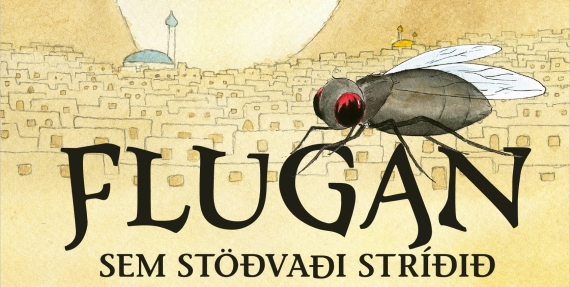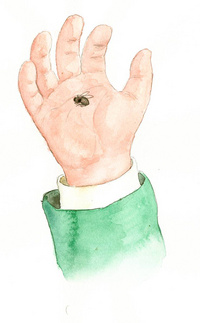The Fly that Ended the War
Bryndís Björgvinsdóttir nimbly navigates the precarious line between humour and gravity in The Fly that Ended the War, this year's winner of the Icelandic Children's Book Award.

The Fly that Ended the War (orig. Flugan sem stöðvaði stríðið), this year's winner of the Icelandic Children's Book Award, is the story of a few houseflies who sensibly decide to make a run for it when their human neighbours mail-order an alarmingly efficient electric flyswatter. Finding themselves without a roof over their heads, the flies set out on a sojourn to the distant country of Nepal, rumoured to be home to gentle monks who wouldn't hurt a fly. On their voyage across the world, the itinerant invertibrates run across the puzzlingly ghoulish phenomenon of war for the first time. Briefly mystified, they come to the conclusion that they can't be having with this sort of nonsense – and set about putting an end to it.
“I wrote the book because I wanted to address war from a viewpoint that children could relate to and understand,” says author Bryndís Björgvinsdóttir. In addition to the Children's Book Award, her book also collected the Icelandic Literature Fund's New Voices Grant, enabling her to recruit the illustrator Þórarinn Már Baldursson (of Maximus Musicus fame) to the project.
Viewpoint of the small
 Successfully navigating the precarious line between humour and seriousness, The Fly that Ended the War offers an original take on a thorny subject. Bryndís admits that writing a children's book on war was far from easy. “On the one hand, I felt that including nightmarish war descriptions in a children's book wasn't an option,” she says. “But trivializing the subject, prettifying war and its consequences – that wouldn't have been right either.”
Successfully navigating the precarious line between humour and seriousness, The Fly that Ended the War offers an original take on a thorny subject. Bryndís admits that writing a children's book on war was far from easy. “On the one hand, I felt that including nightmarish war descriptions in a children's book wasn't an option,” she says. “But trivializing the subject, prettifying war and its consequences – that wouldn't have been right either.”
And so you decided on using flies?
“Houseflies have a simplified perspective on war that may resemble that of a child in some ways. First of all, I think we can assume that flies aren't attuned to the finer points of religion or political history – things grownups often speak of when trying to explain and even justify war.
“Second, the flies see us as we see them: they don't perceive our gender, race, class or age. Their perspective is mostly limited to what humans are actually doing at any given moment, such as pacing around the floor, watching television, eating or sleeping. When it comes to war, what they see is simply humans attacking themselves, hurting themselves. For example, they build an entire city and then reduce it to rubble for no discernible reason. I hoped that this simplified perspective could remind us of the absurdity of war, and how little we truly understand about it.”
The insect's perspective, in other words, isn't so far removed from our own?
“Of all creatures, the housefly has always lived in the closest proximity to us. It's even named after the habitat it shares with us. So in a way, it can be said that the housefly, like war, has been with humanity since the beginning. But despite this, or maybe because of it, we normally think of houseflies as insignificant. We don't know much about them and we kill them casually – even two at a stroke. Therefore, it wasn't only their viewpoint that I found fitting; I also liked the thought of pitting these everyday, unremarkable critters, no bigger than a wrinkled raisin, up against this momentous flaw of human nature: war.”
In the end, we don't understand war
 Preaching rarely goes down well in Icelandic children's books. The Fly that Ended the War has a clear message, to be sure, but its serious subject is counterbalanced by its liveliness and humour. Doesn't a book like this demand a sort of balancing act, if the author wants to avoid the preacher's pulpit?
Preaching rarely goes down well in Icelandic children's books. The Fly that Ended the War has a clear message, to be sure, but its serious subject is counterbalanced by its liveliness and humour. Doesn't a book like this demand a sort of balancing act, if the author wants to avoid the preacher's pulpit?
“As I see it, people ususally resort to preaching when they can't think of any other way of expressing what they're thinking. I have more faith in offering readers to step into the shoes of others, use their imagination and exerercise their empathy, so that they can discover their sense of justice and injustice for themselves.”
Is the book a healthy read for grownups as well?
„Maybe we tend to forget that although an understanding of history and politics can shed some light on why conflicts begin in certain areas, it can't justify them. The flies, whose viewpoint resembles that of children up to a point, remind us that in the end, we don't understand war. And in a way, we can't. The death or mutilation of children because of political strife, for instance, cannot be understood. Maybe grownups will find that this story stirs up a few old feelings and ruminations on war.“
Should parents discuss difficult subjects such as this with their children more often?
“Yes, probably. Of course, we do discuss all kinds of difficult subjects with children. Maybe, however, we avoid the most difficult ones, because we have a hard time discussing them ourselves. For example, we seem to find it easy to discuss the importance of a healthy diet and regular exercise, of avoiding drugs and violence, but when it comes to subjects such as empathy and equal rights, respect for all people and animals – especially those who aren't only different from us, but a rung lower in society – then the going tends to get tough. Perhaps that is exactly where we need to do a better job of cultivating empathy, respect and understanding.
“In this regard, I think the flies can stand in for all the groups who get pushed down in any society – those whom society finds acceptable to ignore, despise, even hurt or kill. At the end of the book, the flies break out into a sort of appeal to humans, asking for an end to this sort of injustice, for improved relations between people, and between grownups, children and animals. Something akin to the monasteries of Nepal on a good day.”
Interview: Davíð K. Gestsson
English translation: Steingrímur Teague
